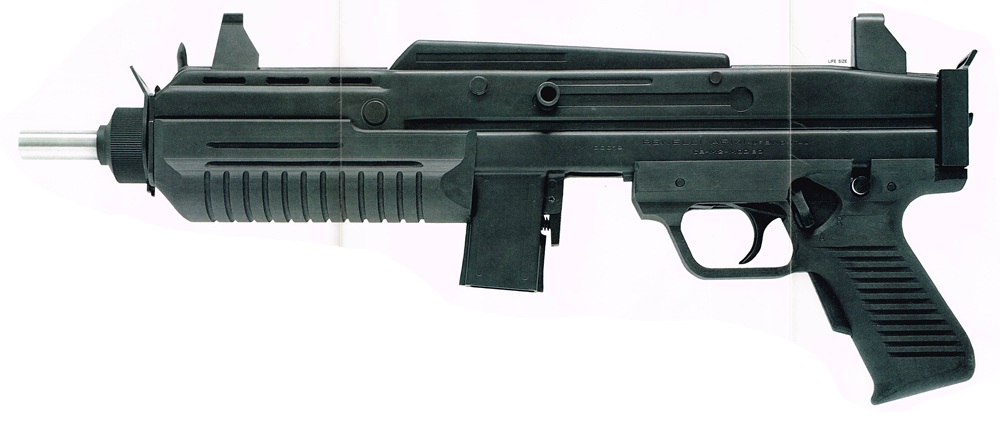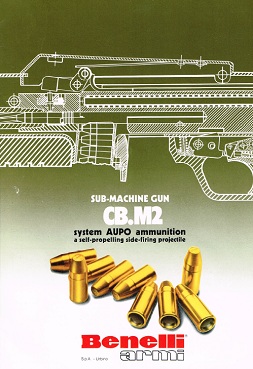The Benelli CB-M2 was a submachine gun designed in the early 1980s around an experimental semi-caseless 9mm cartridge developed by Franchi. The gun itself looks fairly typical, with conventional controls, a bottom-mounted magazine, and polymer folding stock. The one external hint of its unusual nature is an open cutout located between the magazine and trigger guard, which is the ejection port for use when making the gun safe or clearing a dud round.

The 9mm AUPO ammunition (roughly equivalent to 9x19mm in ballistics) used in the CB-M2 is caseless insofar as it does not leave an empty case to be ejected after firing. Instead, the bullet jacket is extruded back as far as a typical 9mm cartridge, and the hollow interior behind the bullet is packed with powder. Instead of a normal primer, a ring of primer compound is built into the case just behind the bullet, much like a rimfire case. The hammer is located above the barrel, and strikes the cartridge through a hole bored in the top of the chamber. In order to affect a functional gas seal (normally done by the expanding brass cartridge case), the bolt runs a significant distance into the chamber. There is an extractor on the bolt which hooks onto the inside lip of the projectile. The extractor is only used for removing live or dud rounds, and is designed to slip off the round upon firing.

In theory, caseless ammunition offers a number of advantages over traditional ammunition: less weight, less firearm complexity, higher rate of fire. One of the major detriments is heat, as the traditional cartridge case acts as a heat sink and removes a significant amount of thermal energy form the gun when ejected. Benelli hoped to address that disadvantage with the 9mm AUPO ammunition, by providing a long and thin brass cylinder to absorb heat and then leave the gun with the bullet. However, adding that extra brass also pretty much negated the theoretical advantage of lightweight caseless ammo. In addition, maintaining a way to extract and eject live rounds left the gun no simpler than any other blowback subgun – more complex than many of them, in fact.
As a result of these rather self-defeating characteristics, it is not particularly surprising that the CB-M2 found brought significant contracts, and was shelved by Benelli in 1985.
Manuals


A similar action might be of use in a grenade launcher, there was a percussion rifle which had charges/balls stacked in the barrel “sort of metal storm” and the hammer was on a moveable track if you will, which you pulled rearwards to line up with seperate nipples one for each charge see. Now if you imagine the cbm2 hammer, ran on a track so if you tipped the weapon up it would slide rearwards via gravity. Anyway, you can get sabots with like spigots attached to there rear for inline muzzle loaders “you put pyrodex pellets around the spigot” and the whole thing is fired out of the muzzle. Soooo… If you imagine a fuse ran inside the spigot and between each pellet was a rim fire, rim “like a washer” that would ignite the fuse, depending on which washer was hit by the hammer would determine the amount of fuse ignited and thus the range ie. It would detonate the grenade “it being attached to the sabot now you see” put wee fins at the end of the spigot. The hammer action would have a certain mass which would act against a spring, the springs resistance would be such as to align the hammer strike with the rims, clearly any rim being struck also activates the main charge.
The 9mm AUPO ammunition was not designed by Franchi. The ammunition is from Fiocchi Munizioni, the biggest ammunition manufacturer of Italy.
I seem to recall seeing an ink line drawing of a similar concept from the 1930s.
Sry, but … the comments on the alleged disadvantages are simply wrong. As might be seen here https://forum.cartridgecollectors.org/t/9mm-aupo-italy/43992/6 (post 6 from the OP counted) the total weight of the cartridge was about 30% LESS than a usual 9mm parabellum, not equal or even more.
The oh-so “complicated” extraction mechanism is a simple hook attached or machined onto the bolt. … without any moving parts or similar “complexity”.
Didn’t found a market most likely due to : “not used by grampa … can’t be good … new things are baaad …”